

 The South African
The South African
Arthur Hazlerigg died on 13 May 1900, aged 27 years, from wounds sustained the day before, during a major Boer attack on Mafeking. He is buried in the Commonwealth War Graves section of Mahikeng Cemetery and listed on the memorial to British soldiers killed during the siege.(1)
Born 31 March 1873 into a distinguished English aristocratic and military family, he was the eldest son of Major-General Thomas Maynard Hazlerigg, Royal Horse Artillery, and grandson of Sir Arthur Grey Hazlerigg, 12th Baronet.(2) Thomas Maynard's elder brother, Lt-Col Arthur Grey Hazlerigg (not the 12th Baronet) died of enteric fever during the Anglo-Zulu War. A brother, Lt-Col Thomas Hazlerigg, RASC, also served in the Second Anglo-Boer War, 1899-1902.
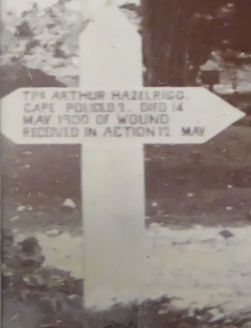
The original grave marker reads:
Tpr Arthur Hazelrigg [sic]. Cape Police.
Died 13 May 1900 of Wound Received in Action 12 May.
This photograph was not in the Journal.
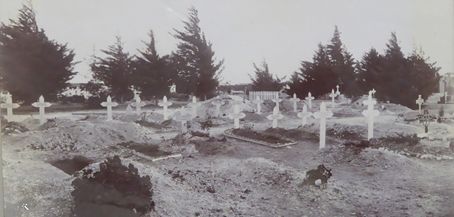
Mahikeng Cemetery. Arthur's grave is at the back on the far left.
Pre-South Africa - The Missing Years 1873-1895
I have been unable to locate a photograph and found little information relating to Arthur's early life. In 1881 he was residing at Noseley Hall, the family seat in Leicestershire, and in 1891, as an 18-year-old scholar, he was with his family at Woolwich, where his father was stationed with the Royal Artillery.(3) Lady Sarah Wilson wrote that whilst nursing Arthur, prior to his death, he told her he had 'failed his military entrance examination'.(4) If true, one might conjecture this failure did not go down well with his family. He emigrated to South Africa, and his Cape Police Attestation Candidates Paper, 1896, records him as: age 23, height 5ft 11¼ inches, fair complexion, dark brown hair, no defining marks, Protestant,and single.(5)
South Africa and the Cape Police 1896
The Cape Police was created under the 1882 Police Regulation Act, as the principal law enforcement agency for Cape Colony, and by 1891/2 was organised into two districts, D1 and D2.
In 1895 British Bechuanaland was annexed to Cape Colony and added to Police District 2. With the outbreak of war in October 1899 the Police were mobilised under military command; and a detachment located at a headquarters in Mafeking thus became involved in its defence.(6)
In 1896, recommended by Superintendent H. J. Scott, Cape Police, Arthur had volunteered as a trooper in the South African Cape Police, D2, enlisting for three years. His Form of Engagement Paper notes his service and pay as dated from 1 June 1896.(7) Arthur completed a Form of Allegiance in his own hand, signing it before George James Boyes, Resident Magistrate of Mafeking on 22 May 1896: "I hereby promise and swear that I will be faithful and bear true allegiance to Her Majesty Queen Victoria and to Her successors according to Law. So Help me God". In his Attestation Candidates Paper, 22 May 1896, in the section, 'trade or calling', Arthur wrote "farmer". As his papers are signed at Mafeking one can assume he was farming in that area (Bechuanaland) at the time. He testified that he had "never served in any Police Force, the Army, the Navy,Coast Guard, Gaol Guard or any other public situation" and therefore had "never been dismissed or discharged from any of the above establishments, or from any situation ... or resigned"; also that he was "not subject to any fits or any other bodily infirmity" and had never, "ever been convicted by a Magistrate for any offence, or been in gaol". The District Surgeon, W. Stanley Heberden (Kimberley), certified, on 22 May 1896, that he had 'examined Arthur Hazlerigg and found him to be sound and in good health, showing no indications of having suffered from any disease likely to incapacitate him in this respect and that he was physically capable of performing the duties of a Police Constable".
As Arthur was awarded the Cape of Good Hope General Service Medal with Clasp for Bechuanaland, he would have been part of the Cape Police's contingent in the Bechuanaland Field Force, raised in February 1897, to put down a native "rebellion" which began in 1896, in response to the Cape Government's measures to stamp out a rinderpest epidemic. The Langberg Campaign saw the defeat of the "rebels" on 30 July and 1 August 1897. Given that Arthur was placed on the Police payroll, on 1 June 1896, and presumably received some training following that date, he might also have been part of the Police detachment sent to arrest a native "rebel" chief in December 1896.

George Boyes,
Resident Magistrate, Mafeking.
Courtesy of Adrian Ellard
Siege of Mafeking, 13 October 1899 -17 May 1900
War was declared by the Boer Republics on the evening of 10 October 1899. From 13 October the Boers, under General "Piet" Cronje, commanding Boer forces in the Western Theatre of War, besieged the strategic town of Mafeking. Mafeking was under the command of Colonel Baden-Powell (B-P), until it was relieved, after 217 days of siege, on 16 May 1900. Cronje departed on 18 November, and General Jacobus Snyman, assisted from April 1900 by Commandant Sarel Eloff, took command of the siege.
Under B-P's command were some 1,183 men, a mixture of regular troops, militia, and volunteers: the Protectorate Regiment, British South African Police [BSAP], Cape Police, Bechuanaland Rifles (local volunteer force), Railway Division, and Town Guard. Also under arms were about 750 Baralong and other native tribesmen. The Cape Police contingent consisted of 103 men: from District 1, under Inspector Charles Sylvester Marsh, 2 officers and 45 men; and from District 2, under Inspector John William Browne, 2 officers and 54 men, including Arthur.(8) The Police performed well during the siege. Major Baillie, war correspondent for the Morning Post, commented that "wherever the Cape Police have had a chance they have done every bit as well as the BSAP".(9) B-P mentions the Police and individual policemen several times in his despatches.
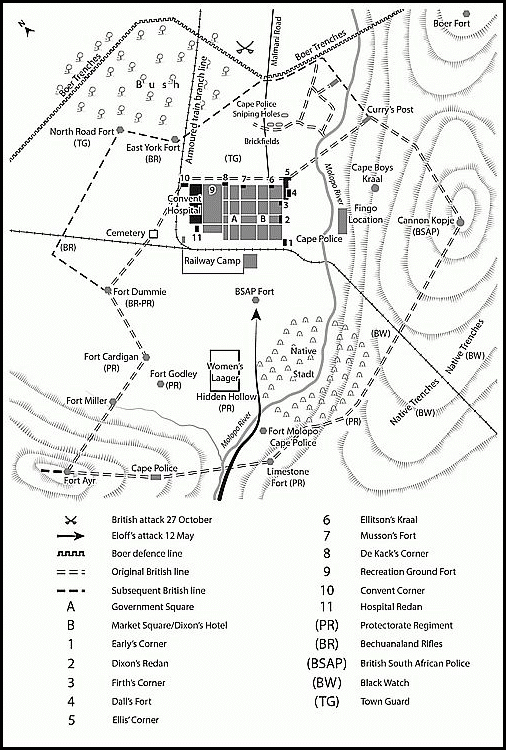
Mafeking Defences and Cape Police positions.
Courtesy George Anderson and Helion Ltd
Positioning the Cape Police, D2, and Arthur within the defences of Mafeking
Lady Wilson wrote that Arthur had "only just been promoted to the post of orderly from being a private in the CapePolice", one of three young men acting as headquarters orderlies, located in the town centre at Dixons Hotel. The Mafeking Mail of 10 March recorded the death of Private Sydney Webb, Cape Police, D2, for a long time employed as B-P's headquarter orderly. He returned "to fight in the Brickfields" preferring to be with his comrades. It is possible that Arthur replaced him although this is not recorded.(10) Each unit was given a sector of the perimeter to hold. A detachment of Police under Inspector Marsh, D1, with a Maxim, supported the west, Fort Ayr, sector and defences to the south. The remainder, under Inspector Browne, D2, supported the south-east and eastern sectors at the Brickfields, which places Arthur, certainly initially, in this sector. In January, about 800 yards due south of Fort Ayr, a new fort was constructed, Fort Molopo, garrisoned by the Cape Police, commanding the bed of the Molopo River. Five hundred yards to the west, front and south of this new D1 post lay Limestone fort.(11)
Baillie writes that Mafeking is situated on a rise about 300 yards (0.27 km) north of the Molopo Riverwhich flows east to west. The town defences were 'garrisoned by theCape Police under Captains Brown and Marsh', along with the Railway Volunteers garrisoning the cemetery and advanced trenches to the north. These arrangements were subsequently much augmented. For the immediate defence of the town, at the south-western corner, was the "pound", garrisoned by thePolice under Captain Marsh, then eastwards to Early's fort, Dixon's redan, Dall's fort, Ellis's corner with the Police and Maxim under Captain Brown.(12) On the eastern front were Ellitson's kraal, Musson's fort, De Knock's, Recreation Ground fort, the convent and hospital. A small defensive work was erected at Convent Corner garrisoned by the Police and a Maxim under Lt. Murray.(13) If Arthur only served with D2 units then he could have been located at any of several points in these defences.
The D2 Police were among units defending the hotly contested Brickfields sector located about 1200 yards to the north-east of the town, running southwards to the north bank of the Molopo River. B-P's initial defensive arrangements did not include the whole of the brickfields, allowing the Boers to infiltrate, building strong entrenchments and sniping positions. To counter this threat the defenders pushed forward outworks. Godley wrote of the Brickfields, "there are over two or three miles of trenches ... a regular labyrinth of forts, trenches, gun emplacements and saps; you never saw anything like it". Gardiner wrote, "among the troops manning this sector were men of the Cape Police, perhaps the most reliable men in the garrison, and the Cape Boys". (men of mixed European and African descent).(14) The Mafeking Mail and Baillie certainly place the D2 Police defending the brickfields and eastern posts. Arthur might well have participated in the successful 27 October attack on Boer trenches north of the Malmani Road, which included two parties of the Cape Police.(15)
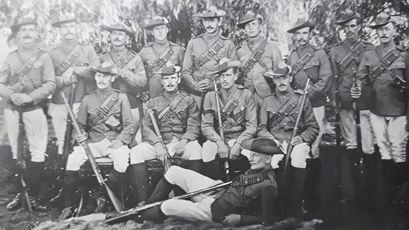
A Detachment of Cape Police.
Courtesy of Zvonimir Navala
References to Hazlerigg in the Mafeking Mail
Editions of the Mafeking Mail record under 'General Orders' several promotions, recognitions of good service and individual increases in pay relating to Cape Policemen, but none refer to Arthur. However, there are references to Arthur taking part in sporting competitions. He might well have participated in many more competitions than those in which he is named, either as an individual or team member, but generally only prize winners or teams are listed by name.
During 1899, Arthur participated in a Cape Police v Protectorate Regiment cricket match, bowling out one of their team and being bowled himself for four runs. He played again as a forward in a Town Team v Protectorate Regiment match. At a Gymkhana Meeting, Arthur participated in the Tent Pegging competition between theCape Police, Protectorate Regiment, BSAP and Bechuanaland Rifles. Arthur did not make the final two rounds but was placed 11th out of 40 participants, which included eight other Cape Policemen. The D2 Police team, which probably included Arthur, won the team event, beating, amongst other teams, the D1 Police. D2 won a Tug-of-War competition but team members are not recorded. However, Arthur was probably included as he is named in the successful D2 team on 10 December. In the same Gymkhana event Arthur was in the winning D2 Tent Pegging team. The Mafeking Mail records, "The winning section took all four pegs 'like one man' in their third run, making an exhibition well deserving the encomium of Colonel Baden-Powell: 'Very good indeed. The finest tent-pegging I have ever seen... '".
1900 saw Arthur playing as a forward in a Cape Police v Mafeking Garrison football match. In February, Arthur was a forward for a Cape Police v Protectorate Regiment match. This is the last mention of Arthur, by name, participating in competitions. The individual Police team members in an April gymkhana are not listed but probably included Arthur in at least one of the events. D2 won the Wrestling on Horseback and came second in the Lloyd Lindsey events.(16)
Boer attack, Saturday 12 May 1900, 214th day of the Siege
General Snyman had hesitated to implement an order from Pretoria instructing him to undertake a long-delayed assault on Mafeking. Frustrated by what he perceived as Snyman's complacent and sluggish manner in conducting the siege, Eloff put forward a plan to make an initial main attack on Mafeking's western defences with Snyman supporting via a feint attack on the eastern defences, then moving to reinforce Eloff in a final assault, thus subjecting the garrison to assaults in front and rear. Snyman eventually and reluctantly agreed to the attack.(17) Some 700 burghers were to be involved; Eloff advancing with about 250 of this force, the remainder held in reserve until the initial attack proved successful. Eloff divided his 250 men into three groups, the largest accompanying Eloff in rushing the BSAP fort, midway between the native Baralong stadt (village) and western edge of the town itself.(18)
Just before 4am the garrison was roused by heavy firing confined to the east. As no attack was expected across the flat country and heavy defences of this sector, attention was paid to other sectors, notably developments on the southwest where Eloff was attacking. Baillie wrote that he went to headquarters and waited for the real attack, which B-P immediately stated would be on the stadt. After about 1½ hours, firing on the eastern front slackened as a conflagration was seen in the west.(19) Eloff advanced from the west along a path beside the Molopo River, passing through Hidden Hollow. The dozen or so piquets fell back until reinforced by some of the Protectorate Regiment, closing to prevent support from Boer reserves. Eloff's vanguard rushed towards the Stadt, setting fire to huts; believed to be the signal for Snyman's force to support Eloff's attack. This support did not materialise. Eloff and about 150 burghers moved round the stadt and believing they were supported by their reserve, had, by about 5.30am, taken the BSAP fort and garrison. However, the Boer force was promptly cut off from further advance by the Protectorate Regiment and without Snyman's promised reinforcement Eloff's progress was halted. The Mafeking Mail states: "a busy time set in, orderlies galloping round to the various forts with instructions". It then records, "Poor Hazlerigg rode up with a note, he was shot in the stomach".
The Mafeking garrison had responded quickly. Western posts of the town had been closed, an inner defence line formed between the stadt and town, deploying reserves - including D2 Cape Police - from the Brickfields. By 4pm Eloff's three isolated groups were completely encircled and pinned down. Eloff held his position under heavy gunfire and sniping throughout the day, but realizing he had been abandoned by Snyman, at 6pm he and 96 burghers surrendered.
Lieutenant, The Hon. Hanbury-Tracey (B-P's Intelligence Officer) wrote, 'We have successfully disposed of enemy's attack and after sixteen hours fighting ... our losses comparatively light and our men behaved splendidly'. He records four severely wounded including 'Hazlerigg of Cape Police' and then on the 14 May, 'Please inform C.S.O No.136 Tpr Arthur Hazlerigg C.P. died of wounds yesterday'.(20)
Death of Arthur Hazlerigg 13 May 1900
B-P wrote, 'our losses were fortunately very light, and while deploring the loss of the good men who fell, we have the satisfaction of knowing that they died in gaining a really telling success to our arms.'.(21) There are several contemporary and conflicting accounts of Arthur's wounds and death which, considering he was only a trooper in the Cape Police might suggest a level of popularity, or the tragic loss of a valued colleague.
As already noted, the Mafeking Mail records, "Poor Hazlerigg rode up with a note, he was shot in the stomach. Mr. Dunlop Smith [Veterinary Lieutenant Dunlop-Smith], with the assistance of Mr. Forbes, conveyed him under a heavy fire ... the whole time he [Smith] was dressing him". B-P, recording cases of gallantry and good service, wrote: "Trooper Hazlerigg, Cape Police, in going to the [now captured BSAP] fort with a message, was shot and mortally wounded. He was put into a small room near the fort, but our fire on the place was so heavy that no one was able to reach him till Veterinary Lieutenant Dunlop-Smithand Mr. Forbes [both captured when the BSAP fort was taken] went out under very heavy fire and got to him, dressed his wounds, and remained with him for two hours".(22) On his move from B-P's headquarters to support the BSAP fort, Baillie wrote, "I saw poor Hazlerigg, who was a personal friend of mine, and whom I knew at home, shot, but did not realise who he was.(23) Another account simply notes, "Hazlerigg killed by rifle fire".(24) Grinnell-Milne wrote, "a fine young fellow from Leicestershire - lay unseen, bleeding to death".(25)
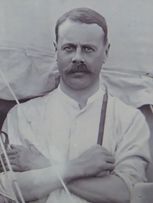
Major Frederick Daniel Baillie, 4th Hussars.
War Correspondent for the Morning Post, Mafeking.
Taylor, D 1901
Edward Ross wrote, "A staff orderly, a man named Hazlerigg of the CP, who had been sent down to reconnoitre [area of the BSAP fort - 500 yds from of town], had been shot and captured by the enemy". He adds, "Eloff put out a Red Cross flag and sent up three of his wounded together with our man Hazlerigg to be attended to in our hospital".(26)
The most comprehensive account is in Captain Herbert Greener's journal of the siege. "Just before the news had arrived that the fort had surrendered, a Cape Police orderly, Hazlerigg, had been sent to try and get in touch with Colonel Hore; the poor fellow's first warning of the enemy being in possession was a bullet into him. Badly wounded, he lay where he fell for hours without attention. His horse, hit at the same time, fell with him.. Later in the day when there were several casualties amongst Eloff's men, he appealed to his prisoners for medical aid, to which Lieut. Dunlop-Smith, Farrier Corporal Nicholas and Forbes, the Canteen Sergeant, responded and after rendering first aid to the wounded in the fort, attended those outside. Under heavy fire, coming from our side, they moved Hazlerigg into the paymaster's office. He was still alive, though bleeding badly. With bullets cracking through the door and windows, attending to his wounds was difficult work, the only sheltered place being in the corner near the safe where one of the enemy was crouching badly wounded, and another standing against the wall." Following the Boer surrender Greener wrote, "All was quiet again. It was a lovely night; calm and clear with a brilliant moon; so still and silent after the horrible racket of the day ... I was sent off to see the PMO[Principal Medical Officer] regarding the dead and wounded ... Then I rode to the fort with one of the doctors ... There were many ghastly sights as we searched round for the wounded ... Outside there lay three dead horses fully saddled, belonging to Hazlerigg and other orderlies who had been on duty when the rush took place.
After receiving first aid, the wounded were placed on stretchers ready to be carried away; the groans of some of the poor fellows and pain depicted in their faces, accentuated by the moonlight, or when lanterns lighted them up in a darkcorner, was pitiable. Poor Hazlerigg died that night. Our losses were small; not half a dozen killed and a few wounded..(27)

BSAP fort and dead horses on the morning of 13 May.
Taylor, D.
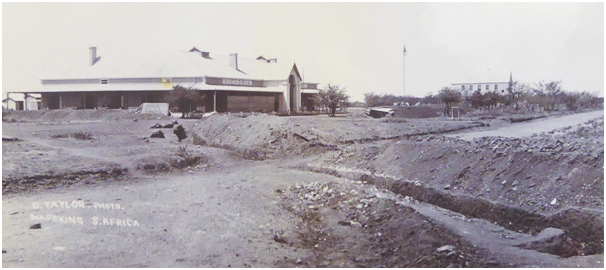
Mafeking Hospital.
Taylor, D.
Lady Wilson, who spent the day working in the Victoria hospital and at some time nursed Arthur wrote: 'The walls sheltered so much suffering, and were, alas! by evening crammed to their fullest capacity. It was a gruesome sight seeing the wounded brought in, and the blood-stained stretchers carried away empty ... Sometimes an ambulance waggon would arrive with four or five inmates; at others we descried a stretcher-party moving cautiously across the recreation-ground towards us with a melancholy load. All were skilfully and carefully attended to by the army surgeon and his staff in a marvellously short space of time, and comfortably installed in bed ... Among the English casualties, one casewas a very sad one. A young man, named Hazlerigg, of an old Leicestershire family, was badly shot in the region of the heart when taking a message to the BSAP fort, not knowing the Boers were in possession. Smart and good-looking, he had only just been promoted to the post of orderly from being a private in the Cape Police . When brought to the hospital, Hazlerigg had nearly bled to death, and was dreadfully weak, his case being evidently hopeless. I sat with him several hours, puttingeau-de-Cologne on his head and brushing away the flies. In the evening, just before he passed into unconsciousness, he repeated more than once: 'Tell the Colonel, Lady Sarah, I did my best togive the message, but they got me first.' He died at dawn." What reads like a peaceful passing away, may not have been the reality. A hospital orderly wrote, 'when the end came, he was fully conscious and shrieked in a high treble voice for about five minutes before he died.'(28)
Jeal in his biography of B-P wrote that the death which affected him most was Arthur's; "over and again in the coming years B-P would tell the story of Hazlerigg's death as an illustration of what devotion to duty should be". In a lecture given to the Eton College Officers' Training Corps during the 1914-1918 war, B-P stated, "I lost my own orderly simply through his being an over brave man. He had got a mistaken order from a man who was drunk, I am afraid [probably Lt. Moncreiffe]. He gave him the order in my name to ride out to the Boers [BSAP Fort] with a message, and told him, 'Never mind if they shoot, get it there.' The Boers fired heavily at him ... After a time, his horse was hit and fell; an ordinary cunning man would have laid low and pretended he was hit too and might have got back safely. But he went on running until finally a shot struck him in the thigh and smashed it ... he knew he was going to his death, but he tried to carry out the order because he had got it". As Jeal wrote, the manner of his death was not quite as B-P made out whenever he used 'my orderly' as the subject of his 'pep talks' to the Boy Scouts. Doing one's duty, 'doing one's best' was an important element in the Boy Scout Promise and may have owed something to Hazlerigg's valiant and fatal effort to carry out his orders.(29)
The accounts vary in detail and in the timing of events but are broadly comparable. It is possible some of the authors shared one another's accounts and were therefore not independent of each other. Greener provides the most clear and detailed account of events leading to Arthur being taken to the Victoria hospital. In summary therefore, as an orderly at B-P's headquarters in Dixon's Hotel, Arthur rode from there over open ground taking a 'mistaken' order to Colonel Hore at the then captured BSAP fort. His horse was hit, and he received a fatal wound. He either lay in the open where he was shot, lying unseen, 'bleeding to death' for several hours and suffering terrible pain, or ran towards the fort. Any of the wounds ascribed to Arthur would have brought about terrible pain and bleeding. His mortal wound was either by rifle fire, shot in the stomach, or in the thigh, which was smashed, or as Jeal writes 'not in the thigh but in the genitals', or 'badly shot in the region of the heart'. At some point Arthur was placed in a small room near the fort receiving treatment from Veterinary Lieutenant Dunlop-Smith and Mr. Forbes, dressing his wounds, and remaining with him for two hours. Greener and Lady Wilson's accounts provide a vivid picture of the carnage and suffering following the Boer surrender. Arthur was conveyed to the Victoria Hospital where he died the next day (214th day of a 217 day siege); either, as might be inferred from Lady Wilson, peacefully after sinking into unconsciousness, or, as the hospital orderly states, fully conscious and in acute pain. A pointless, if heroic, death: the message had been an error.
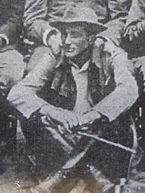
Lt. Ronny Moncreiffe.
Courtesy of Robin Drooglever
Arthur was awarded the Queens South Africa Medal and Clasp for the Defence of Mafeking, and Cape of Good Hope General Service Medal with Clasp for Bechuanaland. The Medal Roll for the Queens South Africa Medal records (4 September 1907) that Arthur's medal and clasp were recovered and reissued to Col. F.A. Yorke for transmission to his father, Major-General Hazlerigg.(30)
The family obituary for Arthur reads: 'Though absent, ever dear. Hazlerigg 13 May, at Mafeking, [died] of wounds, Arthur (Cape Mounted Police) eldest son of Major-General Hazlerigg, late Royal Artillery and grandson of the late Sir Arthur Grey Hazlerigg, 12th Baronet, of Noseley Hall, Leicestershire'.(31)
The following colour photographs appeared on the inside back cover of this Journal.
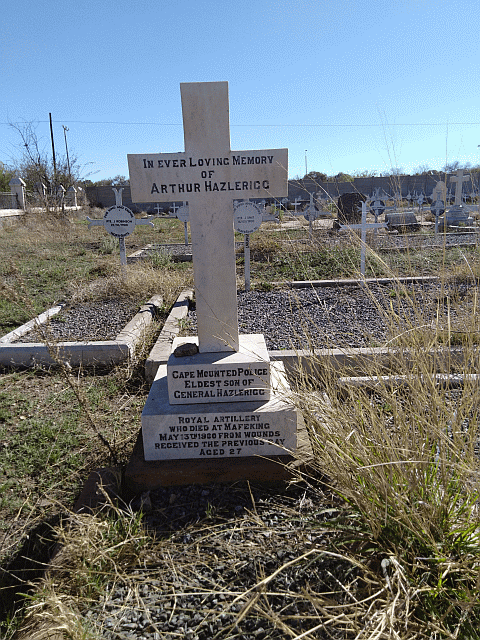
Hazlerigg's grave in the Mafeking Cemetery

The family memorial plaque at Noseley Hall
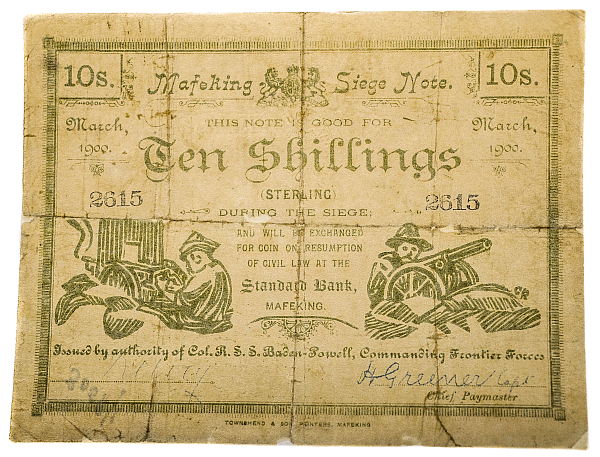
A banknote from the siege of Mafeking
Courtesy of the Museum of the Boer Republics, Bloemfontein
Acknowledgments
This article would not have been possible without the encouragement and support from the late Gillian Hazlerigg (1946-2022). I am extremely grateful for thesupport and encouragement received from William, 4th Baron Hazlerigg and XVI Baronet, and Professor Emeritus Lawrence Hazlerigg. Adrian Ellard has been amazing in providing Cape Police records and providing answers to my many queries. My thanks to: Tim Jeal; Brian Willan for access to the Letters of General Sir Alexander and Lady Godley; The Hon. Algernon Hanbury-Tracey for access to the Hanbury-Tracey Papers; Anglo-Boer War.com; Dr David Biggins; Brian Hill; Robin Drooglever; Commonwealth War Graves Commission; the National Archives; University of Cambridge Library; Archivist Eton College; Archivist Harrow School, Archivist The Keep Archives West Sussex; Leicestershire Archives (Hazlerigg papers); Dr Dane and Dr Vicky Heunis, Oorlogsmuseum, Bloemfontein; Zvonimir Navala; George Anderson for producing the Mafeking map.
Bibliography
Anglo-Boer War.com, 2023.
Baillie, F.D, Mafeking A Diary of the Siege, (London,1900).
Burkes Peerage, Volume 1, 2003.
Cape Argus, 13 September 1900
Constantine, R, 'An Unpublished Mafeking Siege Diary by an Unidentified Officer of the Garrison', Kopje, Kraal, Veldt & Laager 2, Journal of the Anglo-Boer War Museum, pp.93-131,2018.
Drooglever, R (ed), A Monument to British Pluck: Captain Herbert Greener's Journal of The Siege of Mafeking, (Honiton:Token Pub. 2009).
Gardner, B, Mafeking A Victorian Legend, (London: Sphere Books,1968).
Godley, Gen. Sir A, Godley Mafeking Letters, 7 August 1899-21 May 1900.
Unpublished.
Grinnell-Milne, D, Mafeking, (London: Four Square Book,1960).
Hamilton, J.A, The Siege of Mafeking (London: Methuen, 1900).
Hanbury-Tracey, Hon. A, Hanbury-Tracey Papers, File One, Rough Proof Siege of Mafeking. Unpublished.
Hands,C.E, Souvenir of the Siege of Mafeking: being facsimile reproductions of the most interesting General Orders issued to the garrison of Mafeking by General Baden-Powell during the Siege, (London, 1901).
Hazlerigg, L, The Hesilrige/Hazlerigg Family in Great Britain 1066 to 1900s (USA: Florida, 2021).
Jeal, T, Baden-Powell (London: Pimlico, 1991).
London Gazette, 1896.
Mafeking Mail Special Siege Slip Editions, Nos.1-152. Edited G.N.H. Whales, (Mafeking: Townsend and Son, 1 November 1899 to 31 May 1900).
Northampton Mercury, Register Births Deaths and marriages,1900.
Spiers E.M, Letters from Mafeking (Frontline Books, 2018).
Taylor, D, Souvenir of the Siege of Mafeking from Original Photographs
(Mafeking 1901).
Urry, R, Diary, 1900, quoted in Jeal.
Willan, B.P., (ed), Edward Ross Diary of the Siege of Mafeking October 1899 to May 1900, Van Riebeeck Society, Second Series No.11 (Cape Town, 1980).
Wilson, Lady S, South African Memories, (London 1909).
End Notes
1 Original grave markers were wooden crosses largely replaced by metal crosses.
Arthur's grave is marked by a family memorial possibly erected after 1 April 1904 when the Cape Police were renamed Cape Mounted Police. Maintained by the Commonwealth War Graves Commission, Mahikeng, Carrington Street cemetery. The memorial to British soldiers killed during the siege is in the grounds of Mahikeng Museum, Martin Street and lists the four other D2 Cape Police, who lost their lives during the Siege.
2 Arthur was christened 30 April 1873 at St Mary Magdalene, Woolwich, Kent. He had
two brothers and four sisters. Confusingly, Arthur and Arthur Grey are male ancestral family Christian names.
3 British Census Records,1881 and 1891. Hazlerigg, pp.543-544. Male members of
the family appear to have attended Eton or Harrow schools except for Arthur and his
father.
4 Wilson, Lady Sarah, Chapter XIII,pp.209-210.
5 Arthur Hazlerigg: Cape Police Attestation Papers (Ref:CMP 18), The National Archives of South Africa Western Cape Archives and Records Service. My thanks to Adrian Ellard for transcripts.
6 Anglo-Boer War.com/South African Units, 2023
7 Arthur signed his papers before Superintendent Scott at Mafeking, 22 May 1896.
A Major H. Scott of the Cape Police committed suicide on 15 November 1899 at
Vryburg close to Mafeking. Information supplied by Adrian Ellard.
8 Jeal, p.228, for the native contingent. Confusingly: there are two spellings used for Brown/Browne. The latter spelling appears on his Cape Police papers. Browne and Marsh are both referred to as either captains or inspectors. Cape Police papers only refer to them as Inspectors with a local rank of Major. There was also a Captain F.C.Marsh of the Protectorate Regiment; it is not always clear therefore which one is being referred to. C.S. Marsh later changed his name to Edensor.
9 Major Fredrick David Baillie, p.71.1896 Captain, 4th Hussars, Augmented Major 18 November 1896, London Gazette, 273, 1896. B-P refers to Baillie's drunkenness,
see Spiers, p.125.
10 The Mafeking Mail, No.91, 13 March 1900. Jeal,p.298.
11 Baillie, pp.30, 113.
12 It is not clear whether this is Captain Marsh of D1 or Marsh of the Protectorate
Regiment.
13 Lt. Murray, probably Protectorate Regiment. Baillie, p.29, entry for Sunday 22
October, also p.31.
14 Godley Mafeking Letters, 20 March 1900, p.213. Sadly Gardiner, pp.144-145,
did not give his source for his statement. Baillie p.52.
15 The Mafeking Mail for example Nos. 34,65,91,100. Baillie, pp.34-36, 38, 170, 213, 215.
16 The Mafeking Mail, editions Nos. 9, 19, 25, 31, 60, 65, 115.
17 I have used The Mafeking Mail Special Siege Slip Editions extensively for this section. No.142 Monday, 14 May 1900 and No.143, Wednesday, 16 May 1900. Spiers, p.125.
18 The fort was an obsolete old work, constructed during Sir Charles Warren’s 1884 expedition and only slightly fortified; a rectangular stone house along with half dozen mud-brick barrack buildings stood nearby.
19 Baillie, pp.253-254.
20 Hanbury Tracey Papers:1379, 2 May;1381,13 May;1383-4,14 May
21 The Mafeking Mail No.143 Wednesday, 16 May 1900.
22 The Mafeking Mail, No.143 Wednesday,16 May 1900, re events in Mafeking 15 May, "Gallantry". Hands, General Orders, Tuesday 15 May 1900.
23 There is an 11-year age difference between Arthur and Baillie and I have been unable to find any link between them prior to Mafeking.
24 Personal correspondence with Rodney Constantine and Constantine, R, p.129, entry for 12 May 1900.
25 Baillie pp.253-254. Grinnell-Milne, p.164, unfortunately, he does not provide a source for this statement.
26 Willan,1980,pp.225-226.
27 Drooglever, pp.131,133,135-136.
28 Wilson, Lady Sarah Wilson, pp.209-210. Urry, R, [Manager of the Standard Bank,
Mafeking], Diary, 12 May 1900, in Jeal p.299. The Diary was in Mafeking Museum but on my visit in 2018 the whole archive was presumed lost.
29 Ronny Moncreiffe (1864-1909) was the son of Sir Thomas Moncrieffe of that ilk, 7th Baronet. A Captain in the Worcestershire Imperial Yeomanry, he fought in the 1896 Matabeleland Campaign and took part in the Jameson Raid. He was recruited locally by B-P and was on his Staff throughout the Siege, except when under close arrest. A friend of the Prince of Wales and celebrated gambler and bon viveur, Moncrieffe
succumbed to the pressure of the siege and began drinking heavily, suffering a mental collapse/breakdown. Godley writes of "poor Ronny Moncrieffe ... whenever there had been any dirty jobs, taking messages to outlying forts on dark rainy nights, or going out with flags of truce to get shot at by the Boers, he has always gone". Baillie, p.104. Jeal, pp.298-299. B-P quoted in the Cape Argus 13 September 1900. Godley Mafeking Letters, 6 May 1900, p.282. Burkes Peerage, p.1339.
30 I am grateful for information from Sheelagh Bell (nee Hazlerigg), Catrina Jaeger (nee Hazlerigg), Adrian Ellard, Brian Hill and David Biggins Anglo-Boer War.com, 18.4.23.
Arthur Robert Hazlerigg sold Arthur's medals at Sotheby's May 1980 (part Lot, sold with other family medals); then Spink June 1990, £850 and Liverpool Medals November 1990, £1,050. Northampton Mercury, Friday 29 June 1900,
p.8. I am grateful to Brian Hill for this reference.
About the author
Graham Winton (PhD, FRGS, FRHistS), retired in 2008 as Principal of an Adult Education College to concentrate on research and publishing. A part-time tutor with the University of Cambridge Institute of Continuing Education for over twenty years, he has lectured in the South Africa, USA, India and extensively in Britain on military and landscape history, particularly relating to the Indian Army, Second Anglo-Boer War 1899-1902 and First World War 1914-19.
He has written and published widely on military horses, army remounts and veterinary services; his major publication is Theirs Not To Reason Why: Horsing theBritish Army 1875-1925 (Helion, 2014).
Graham is currently working on the Anglo-Boer War diary of Veterinary Captain John Moore (later Maj-Gen SirJohn Moore, Director of Veterinary Services on the Western Front 1914-1919) during the Northwest Frontier campaign of 1899-1900 with Colonel Plumer and Baden-Powell; and the Anglo-Boer war Services of the Hazlerigg and Birkbeck families.
Graham has featured in BBC/ITV television and radio programmes relating to horses in the First World War and filming in France on the work of the much-forgotten draught horse during the 1914-1919 War.
Return to Journal Index OR Society's Home page
South African Military History Society / scribe@samilitaryhistory.org